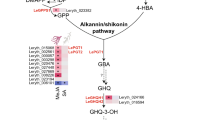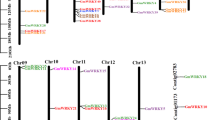Abstract
Medicinal Salvia miltiorrhiza is renowned for its curative effects on cardiovascular diseases. Its biologically active ingredients include rosmarinic acid (RA) and its derivative, salvianolic acid B (SAB). We used available bioinformatics tools to improve our knowledge about the biosynthesis of these phenolic compounds. Our comprehensive description of cis-acting regulatory elements in the RA pathway provides insights into the potential transcriptional regulation of that pathway. For example, a light-responsive element was the most abundant and widespread motif, suggesting that light is a universal regulatory factor of RA synthesis in S. miltiorrhiza. Therefore, we examined gene transcripts and the accumulation of hydrophilic pharmacological compounds in light-treated plants. Canonical correlation analysis was also used to construct a gene-to-metabolite network. We obtained a high correlation coefficient (0.986), which generally indicated a clear and close relationship between RA-biosynthetic genes and desirable metabolites. We also screened PAL1, C4H, and HPPR, genes directly linked to the accumulation of RA and SAB. Our results can serve as the basis for better understanding RA synthesis in S. miltiorrhiza, and they will increase the practical potential for metabolic engineering of this important medicinal species.





Similar content being viewed by others
References
Achnine L, Blancaflor EB, Rasmussen S, Dixon RA (2004) Colocalization of l-phenylalanine ammonia-lyase and cinnamate 4-hydroxylase for metabolic channeling in phenylpropanoid biosynthesis. Plant Cell 16:3098–3109
China Pharmacopoeia Committee (2010) Chinese Pharmacopoeia of People’s Republic of China. Chemical Industry, Beijing, p 71
Cukovic D, Ehlting J, van Ziffle JA, Douglas CJ (2001) Structure and evolution of 4-coumarate: coenzyme A ligase (4CL) gene families. J Biol Chem 382:645–654
Dean C, Schmidt R (1995) Plant genomes: a current description. Annu Rev Plant Physiol Plant Mol Biol 46:395–418
Dixon RA, Paiva NL (1995) Stress-induced phenylpropanoid metabolism. Plant Cell 7:1085–1097
Dong J, Wan G, Liang Z (2010) Accumulation of salicylic acid-induced phenolic compounds and raised activities of secondary metabolic and antioxidative enzymes in Salvia miltiorrhiza cell culture. J Biotechnol 148:99–104
Franklin AE, Cande WZ (1999) Nuclear organization and chromosome segregation. Plant Cell 11:523–534
Fukunaga K, Fujikawa Y, Esaka M (2010) Light regulation of ascorbic acid biosynthesis in rice via light responsive cis-elements in genes encoding ascorbic acid biosynthetic enzymes. Biosci Biotechnol Biochem 74:888–891
Gilmartin PM, Sarokin L, Memelink J, Chua NH (1990) Molecular light switches for plant genes. Plant Cell 2:369–378
Halliday KJ, Fankhauser C (2003) Phytochrome-hormonal signalling networks. New Phytol 157:449–463
Huang B, Duan Y, Yi B, Sun L, Lu B, Yu X, Sun H, Zhang H, Chen W (2008a) Characterization and expression profiling of cinnamate 4-hydroxylase gene from Salvia miltiorrhiza in rosmarinic acid biosynthesis pathway. Russ J Plant Physiol 5:431–440
Huang B, Yi B, Duan Y, Sun L, Yu X, Guo J, Chen W (2008b) Characterization and expression profiling of tyrosine aminotransferase gene from Salvia miltiorrhiza (Dan-shen) in rosmarinic acid biosynthesis pathway. Mol Biol Rep 35:601–612
Ibraheem O, Botha CE, Bradley G (2010) In silico analysis of cis-acting regulatory elements in 5′ regulatory regions of sucrose transporter gene families in rice (Oryza sativa japonica) and Arabidopsis thaliana. Comput Biol Chem 34:268–283
Kim KH, Janiak V, Petersen M (2004) Purification, cloning and functional expression of hydroxyphenylpyruvate reductase involved in rosmarinic acid biosynthesis in cell cultures of Coleus blumei. Plant Mol Biol 54:311–323
Liu AH, Li L, Xu M, Lin YH, Guo HZ, Guo DA (2006) Simultaneous quantification of six major phenolic acids in the roots of Salvia miltiorrhiza and four related traditional Chinese medicinal preparations by HPLC-DAD method. J Pharm Biomed Anal 41:48–56
Ma L, Zhang X, Guo H, Gan Y (2006) Determination of four water-soluble compounds in Salvia miltiorrhiza Bunge by high-performance liquid chromatography with a coulometric electrode array system. J Chromatogr B Analyt Technol Biomed Life Sci 833:260–263
Minami E, Ozeki Y, Matsuoka M, Koiruka N, Tanaka Y (1989) Structure and some characterization of the gene for phenylalanine ammonia-lyase from rice plants. Eur J Biochem 185:19–25
Petersen M (2007) Current status of metabolic phytochemistry. Phytochemistry 68:2847–2860
Petersen M, Simmonds MS (2003) Rosmarinic acid. Phytochemistry 62:121–125
Petersen M, Haüsler E, Karwatzki B, Meinhard J (1993) Proposed biosynthetic pathway for rosmarinic acid in cell cultures of Coleus blumei Benth. Planta 189:10–14
Petersen M, Abdullah Y, Benner J, Eberle D, Gehlen K, Hücherig S, Janiak V, Kim KH, Sander M, Weitzel C, Wolters S (2009) Evolution of rosmarinic acid biosynthesis. Phytochemistry 70:1663–1679
Rischer H, Oresic M, Seppanen-Laakso T, Katajamaa M, Lammertyn F, Ardiles-Diaz W, van Montagu MC, Inze D, Oksman-Caldentey KM, Goossens A (2006) Gene-to-metabolite networks for terpenoid indole alkaloid biosynthesis in Catharanthus roseus cells. Proc Natl Acad Sci USA 103:5614–5619
Rombauts S, Déhais P, van Montagu M, Rouzé P (1999) PlantCARE, a plant cis-acting regulatory element database. Nucl Acids Res 27:295–296
Singh KB, Foley RC, Onate-Sánchez L (2002) Transcription factors in plant defence and stress responses. Curr Opin Plant Biol 5:430–436
Song J, Wang Z (2009) Molecular cloning, expression and characterization of a phenylalanine ammonia-lyase gene (SmPAL1) from Salvia miltiorrhiza. Mol Biol Rep 36:939–952
Song J, Wang Z (2011) RNAi-mediated suppression of the phenylalanine ammonia-lyase gene in Salvia miltiorrhiza causes abnormal phenotypes and a reduction in rosmarinic acid biosynthesis. J Plant Res 124:183–192
Wang H, Ma LG, Li JM, Zhao HY, Deng XW (2001) Direct interaction of Arabidopsis cryptochromes with COP1 in light control development. Science 294:154–158
Wyeth WW, Albin S (2004) Applied bioinformatics for the identification of regulatory elements. Nat Rev Genet 5:276–287
Xiao Y, Gao S, Di P, Chen J, Chen W, Zhang L (2009) Methyl jasmonate dramatically enhances the accumulation of phenolic acids in Salvia miltiorrhiza hairy root cultures. Physiol Plant 137:1–9
Yan Q, Shi M, Ng J, Wu JY (2006) Elicitor-induced rosmarinic acid accumulation and secondary metabolism enzyme activities in Salvia miltiorrhiza hairy roots. Plant Sci 170:853–858
Zhang Y, Yan Y, Wang Z (2010) The Arabidopsis PAP1 transcription factor plays an important role in the enrichment of phenolic acids in Salvia miltiorrhiza. J Agric Food Chem 58:12168–12175
Zhao SJ, Hu ZB, Liu D, Leung FC (2006) Two divergent members of 4-coumarate:coenzyme A ligase from Salvia miltiorrhiza Bunge: cDNA cloning and functional study. J Integr Plant Biol 48:1355–1364
Zhou L, Zuo Z, Chow MS (2005) Danshen: an overview of its chemistry, pharmacology, pharmacokinetics, and clinical use. J Clin Pharmacol 45:1345–1359
Acknowledgments
This work was supported by the 11th “five-year technique project” of the Ministry of Science and Technology of the People’s Republic of China (2006BAI06A12-04), and by the Postdoctoral Foundation of China (20110491648).
Author information
Authors and Affiliations
Corresponding author
Additional information
Communicated by M. Stobiecki.
Electronic supplementary material
Below is the link to the electronic supplementary material.
Supporting Information: Additional Supporting Information may be found in the online version of this article:
Rights and permissions
About this article
Cite this article
Song, J., Ji, Y., Xu, K. et al. An integrated analysis of the rosmarinic acid-biosynthetic genes to uncover the regulation of rosmarinic acid pathway in Salvia miltiorrhiza . Acta Physiol Plant 34, 1501–1511 (2012). https://doi.org/10.1007/s11738-012-0948-4
Received:
Revised:
Accepted:
Published:
Issue Date:
DOI: https://doi.org/10.1007/s11738-012-0948-4




